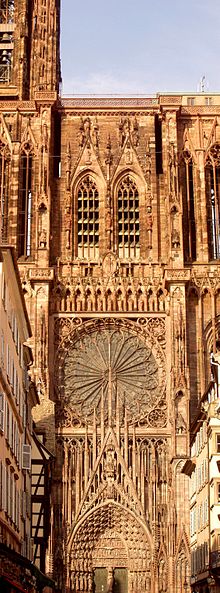Strasbourg Cathedral

The Cathédrale Notre-Dame (English Our Lady's Cathedral) in Strasbourg, France belongs to the grand history of European cathedral architectural design.
Werner de Habsbourg proposed the construction of the cathedral in 1015 AD., and it took six centuries to complete. Like the city Strasbourg, the cathedral connects Muenster German and French cultural influences, while the eastern structures, e.g. the choir and south portal, still have very Romanesque features.
Above all the famous west front, decorated with thousands of figures, is a masterpiece of the Gothic era. The tower is one of the first to rely substantially on draftsmanship, with the final appearance being one of a high degree of linearity captured in stone. While previous façades were certainly drawn prior to construction, Strasbourg has one of the earliest façades whose construction is inconceivable without prior drawing. Strasbourg and Cologne Cathedral together represent some of the earliest uses of architectural drawing. The work of Professor Robert O. Bork of the University of Iowa suggests that the design of the Strasbourg facade, while seeming almost random in its complexity, can be constructed using a series of rotated octagons.
The north tower, completed in 1439, was, until 1874, the highest building of the world. The Strasbourg cathedral is, with its characteristic asymmetrical form (the south tower was never built), today the premier landmark of Alsace. One can see three kilometers from its tower, which provides a view of the Rhine banks from the Vosges all the way to the Black Forest.
